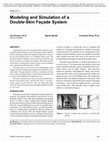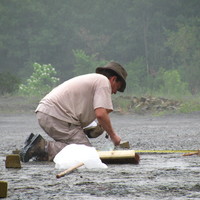Papers by Kamran Sharifabadi

Journal of physics, May 1, 2022
Abstract Advances in large-scale green hydrogen production (LGHP) create commercial opportunities... more Abstract Advances in large-scale green hydrogen production (LGHP) create commercial opportunities for enhancing rapid offshore wind farm (OWF) development. This study investigates whether LGHP co-location at OWF sites improves those OWF’s economic outlooks under potential electrical grid capacity bottlenecks towards 2050. Eight cases have been studied using measured annual OWF power production series and cost estimation integrated with offshore engineering experience: i) two base cases: 2 GW OWFs with HVAC and HVDC transmission infrastructure showing that the levelized cost of electricity (LCOE) increases, and ii) six LGHP co-location cases demonstrating that the calculated levelized cost of hydrogen (LCOH) reduces when the LGHP capacity increases from 20% to 50%, and 100% of 2 GW. Furthermore, three economic improvement factors studied are: i) utilizing existing gas pipelines reducing LCOH by 7.5%, ii) hydrogen for offshore customers changing “no-go” projects to “go”, and iii) scaling-up from 2 to 4 GW reduced the LCOH by 17%. This study shows that LGHP co-location is effective at maintaining OWF full production, but has higher risks including i) LGHP co-location safety at OWFs, ii) high costs to cover more operational conditions and iii) running LGHP operations using high, fluctuating OWF power. Further R&D of LGHP co-location are recommended.

Version Date Main modification Author 5.4 2019-04-15 Edited introduction and GIS content from D15... more Version Date Main modification Author 5.4 2019-04-15 Edited introduction and GIS content from D15.2 Poul Sørensen 5.3 2019-04-07 Added TC95 and approved Geraint Chaffey 5.2 2019-03-29 Comments on missing inputs incl revision of offshore consumption section based on Nicola's input Poul Sørensen 5.1 2019-02-27 Review version: Included Ömers updates to 3.4 Poul Sørensen 5.0 2019-02-24 V4.4 all accepted Poul Sørensen 4.4 2019-02-24 Editing and adding IEC TC8 Poul Sørensen 4.3 2019-02-20 Update and review Geraint Chaffey 4.2 2019-02-19 Update and review Christina Brantl 4.1 2019-02-19 Update and review Geraint Chaffey 4.0 2019-02-18 Version 3.15 with all changes accepted Poul Sørensen 3.15 2019-02-17 Moved CIGRE SCA3 from 3.3.3 to 2.1.1 and updated IEC TC17A AHGs from 3.3.3 to 2.2.4 Poul Sørensen 3.14 2019-02-14 Drafted 3.3 switchgear except for 3.3.4 GIS Cornelis Plet 3.13 2019-02-13 Moved up general intro from 3.2 to Chapter 3 Geraint Chaffey 3.12 2019-02-11 Added switchgear WGs CIGRE SCA3 and updated IEC TC17A AHGs to 3.3.3 Rene Smeets 3.10 2019-02-10 Update chapter 3.1, plus subchapters 3.2.1 and 3.2.2 Christina Brantl 3.9 2019-02-09 Update 3.4 including drafts for harmonics, grid forming and EMT modllling.
John Wiley & Sons, Ltd eBooks, Aug 26, 2016

This chapter provides an overview on how different European regulatory frameworks impact the desi... more This chapter provides an overview on how different European regulatory frameworks impact the design optimization and ownership of HVDC schemes used for the export of offshore wind energy to the mainland. Main components of the offshore and onshore modular multilevel converter high‐voltage direct current (MMC‐HVDC) converters are presented with a brief introduction to various offshore platform technologies. In Europe, the third legislative package for the internal EU gas and electricity market released by the European Council requires the unbundling of ownership between transmission assets and generation assets. The implementation and adaption of this regulatory framework has resulted in two different European models for the construction and ownership of offshore generation and transmission assets. The choice of HVAC platform location is influenced by several factors: requirements from shipping and aviation authorities; water depth and seabed condition; and ac cable voltage profile and cable losses.

Most of the modular multilevel converter high???voltage direct current (MMC???HVDC) projects are ... more Most of the modular multilevel converter high???voltage direct current (MMC???HVDC) projects are planned and developed as point???to???point transmission scheme projects, where the HVDC equipment are designed, manufactured, and installed by the same HVDC original equipment manufacturer (OEM). The HVDC project customers define the functional requirements, including the grid???code requirements that must be fulfilled by the procured equipment. Different grid codes impose different sets of technical requirements which must be fulfilled by the voltage???source converter HVDC (VSC???HVDC) equipment. There are ongoing efforts by European Network of Transmission System Operators for Electricity (ENTSO???E) to harmonize the European grid codes. This chapter provides an overview of standards applicable to HVDC equipment developed by professional associations in the field of MMC???HVDC technology. CIGRE Study Committee B4 (SC B4) addresses all the relevant target groups in the power industry interested in different aspects of power electronics, HVDC, and flexible alternating current transmission system (FACTS).

Line‐commutated converter high‐voltage direct current (LCC‐HVDC) transmission technology is widel... more Line‐commutated converter high‐voltage direct current (LCC‐HVDC) transmission technology is widely recognized as being advantageous for bulk power transmission over long distances, asynchronous interconnections of ac power systems, and interconnectors with long submarine cable. New modular multilevel converter (MMC) designs have broadened the potential range of HVDC transmission to include application of HVDC schemes in weak ac networks. MMC‐HVDC technology is foreseen as the most suitable technology for development of multi‐terminal direct current (MTDC) networks. This chapter presents different HVDC scheme configurations and MTDC configurations. It describes various dc grid control and protection strategies, including dc breaker technologies. The LCC‐HVDC transmission is the preferred transmission technology for bulk power transmission with overhead power lines over long distances. The LCC‐HVDC transmission technology cannot be utilized in weak ac networks, such as islanded offshore WPPs. Finally, the chapter presents dc breaker technologies with passive components and solid‐state hybrid breaker technologies.
John Wiley & Sons, Ltd eBooks, Aug 26, 2016

John Wiley & Sons, Ltd eBooks, Aug 26, 2016
This chapter explains the circuit topology and the operation of modular multilevel converters (MM... more This chapter explains the circuit topology and the operation of modular multilevel converters (MMCs), and put them into their context. It begins with a review of other voltage source converter (VSC) topologies, starting with the two‐level voltage source converter. The chapter seeks the development of cascaded converter topologies with a strong focus on MMCs for ac/dc conversion. Multilevel converters have more than one dc link capacitor, which means that several separate dc levels can be created inside the converter. The blocking capability requirements of the semiconductor valves is determined by the individual capacitor voltages rather than by the full dc link voltage. The chapter describes a couple of multilevel VSCs that were introduced and developed before the MMC and other cascaded topologies, namely the diode clamped topologies and flying capacitor topologies. MMCs with full‐bridges are also seriously considered for HVDC applications thanks to the capability of maintaining current control even during dc‐side short‐circuit faults.
John Wiley & Sons, Ltd eBooks, Aug 26, 2016

15th International Conference on Developments in Power System Protection (DPSP 2020), 2020
Integrating multiterminal high-voltage direct-current (HVDC) connections into the existing altern... more Integrating multiterminal high-voltage direct-current (HVDC) connections into the existing alternating current (AC) power transmission system is a possible solution for transport of large amounts of renewable energy. Protection is considered a key enabler for multiterminal HVDC (MTDC) grids. Designing such a protection system is a challenge, in particular in a multivendor setup. Fault detection during transients might be required to achieve the stringent speed requirements for HVDC protection. This in turn requires knowledge about the expected system behaviour during faults and involves knowledge from all vendors supplying equipment in MTDC grid. Traditionally, HVDC projects are, however, supplied as turn-key solutions and the control and protection systems are the intellectual property of the vendors and not open for the HVDC endusers. This paper aims to provide a starting point on the discussion which information has to be shared between vendors and HVDC end-users when designing MTDC grid protection. Simulations results show that missing information about certain aspects can lead to a failure of the protection system. A discussion on organization of the available information is added. Open specifications of the used equipment are useful to design safe and reliable MTDC grid protection.

John Wiley & Sons, Ltd eBooks, Aug 26, 2016
This chapter provides an understanding of various design choices for different parts of the main ... more This chapter provides an understanding of various design choices for different parts of the main circuit of modular multilevel converters (MMCs). This includes power semiconductors, submodule capacitors, arm inductors, submodule design, redundant submodules, auxiliary power supplies, and start‐up procedures. The design of the main circuit of an MMC involves several steps, ranging from dimensioning of main‐circuit components to issues with auxiliary power supplies and start‐up procedures. The chapter starts with a presentation of the power semiconductors used in MMCs today, and possible future alternatives. Submodule capacitors are voluminous and costly, and as such they deserve considerable attention. It describes arm inductors and different possible submodule configurations. The chapter provides an insight into the main physical properties of power semiconductor devices without going into all details of the underlying semiconductor physics. Arm inductors for MMCs in HVDC applications are typically dry‐type air‐core reactors. The gate‐drive units of these devices, however, require a significantly higher power supply.

The system studied in this article is a multi-terminal HVDC (MTDC) network composed by four volta... more The system studied in this article is a multi-terminal HVDC (MTDC) network composed by four voltage-source converter terminals. It is intended to be a model of the future “super-grid” in the North Sea, where Norway, Germany and the UK are interconnected together with offshore wind farms on the east coast of England. The main challenges related with multi-terminal HVDC grids are market and regulatory issues, control and coordination of the grid, and protection and circuit-breakers. This article focuses on the technical challenges, especially those in relation with DC voltage control and power flow balancing. Several studies have proposed different methods for controlling the DC voltage in MTDC grids. This article uses a DC voltage droop control scheme. The system is analysed by means of simulations and experimentally in a down-scaled laboratory model with ratings in the range of 60 kVA. In order to evaluate the robustness of the droop-control strategy, several large disturbances are emulated: abrupt variation in wind production, sudden change in droop line set-points and loss of two converter terminals during full wind production. Finally, the similarities and differences between the experimental set-up and a real system are discussed.
This paper investigates the possibilities of supplying offshore oil and gas platforms with power ... more This paper investigates the possibilities of supplying offshore oil and gas platforms with power from the onshore power grid combined with offshore wind power. A system consisting of five oil and gas platforms connected to an offshore wind farm with a common VSC-HVDC link to the onshore power grid is studied. A model of the system is developed in MATLAB®/Simulink® and simulations are preformed for two critical system disturbances. The HVDC control system is designed and tuned in order to obtain stable offshore grid operation. The simulation results demonstrate that the system configuration is able to withstand severe dynamic events.
Marine Technology Society Journal, Mar 1, 2014

Interconnecting offshore wind power plants with oil and gas installations (O&G) can create a ... more Interconnecting offshore wind power plants with oil and gas installations (O&G) can create a positive symbiosis for both installations. An O&G installation may reduce the emissions generated by gas turbines installed on platforms and the wind farm may reduce the investment costs by removing expensive transmission links to the shore. The power demand of an O&G-installation lies in the same range as a small to medium sized wind power plant. This paper analyzes methods of maintaining secure operation of such offshore interconnected power systems. The combination of high reliability requirements and low system inertia is challenging. Hence, an adequate overall control strategy is of major importance. As such interconnected systems are not yet implemented, this paper is based on a system with typical ratings. The first and main part demonstrates how wind turbines can contribute to an improved robustness and stability of the system. This is realized through a control concept called inertia emulation. The second part of the paper quantifies the impact on O&G operations in terms of fuel saving and wind variability issues.
IECON 2020 The 46th Annual Conference of the IEEE Industrial Electronics Society
Increased penetration of HVDC and FACTS in the AC network impact’s the grid performance and relia... more Increased penetration of HVDC and FACTS in the AC network impact’s the grid performance and reliability. When HVDC links are connected in close proximity, such devices may have undesired interaction and impact on AC network performance. To assess these risks, offline and real-time (RT) simulation are conducted by vendors, utilities or third parties. The objective of this paper is to describe the use of hardware-in-the-loop (HIL) simulation with physical C&P (control and protection) cubicles in an industrial context. Three innovative projects with focus on interaction studies are conducted at RTE facilities and the results are presented in this paper. Challenges and experiences for interaction studies in HIL simulations are also provided.

Journal of Physics: Conference Series
Advances in large-scale green hydrogen production (LGHP) create commercial opportunities for enha... more Advances in large-scale green hydrogen production (LGHP) create commercial opportunities for enhancing rapid offshore wind farm (OWF) development. This study investigates whether LGHP co-location at OWF sites improves those OWF’s economic outlooks under potential electrical grid capacity bottlenecks towards 2050. Eight cases have been studied using measured annual OWF power production series and cost estimation integrated with offshore engineering experience: i) two base cases: 2 GW OWFs with HVAC and HVDC transmission infrastructure showing that the levelized cost of electricity (LCOE) increases, and ii) six LGHP co-location cases demonstrating that the calculated levelized cost of hydrogen (LCOH) reduces when the LGHP capacity increases from 20% to 50%, and 100% of 2 GW. Furthermore, three economic improvement factors studied are: i) utilizing existing gas pipelines reducing LCOH by 7.5%, ii) hydrogen for offshore customers changing “no-go” projects to “go”, and iii) scaling-up fr...

Starting from a practical design problem related to natural and hybrid ventilation systems, this ... more Starting from a practical design problem related to natural and hybrid ventilation systems, this paper looks at different airflow modeling methods that might be employed to assist in the decision-making process of a building design team. The question at hand is whether or not to make use of a double-skin façade system in a new office development. The airflow modeling methods considered are the mass balance network method and computational fluid dynamics (CFD). The paper gives an overview of the methodology of the design study. The underlying modeling and simulation work is elaborated. The paper finishes with some conclusions, both in terms of the actual performance of the double-skin facade and in terms of the modeling and simulation work. The main conclusions are that, for the foreseeable future, the network method is more suited for this type of "everyday" design support work. However, there are important areas where the network method in general might benefit from CFD, or vice-versa.

Version Date Main modification Author 5.4 2019-04-15 Edited introduction and GIS content from D15... more Version Date Main modification Author 5.4 2019-04-15 Edited introduction and GIS content from D15.2 Poul Sørensen 5.3 2019-04-07 Added TC95 and approved Geraint Chaffey 5.2 2019-03-29 Comments on missing inputs incl revision of offshore consumption section based on Nicola's input Poul Sørensen 5.1 2019-02-27 Review version: Included Ömers updates to 3.4 Poul Sørensen 5.0 2019-02-24 V4.4 all accepted Poul Sørensen 4.4 2019-02-24 Editing and adding IEC TC8 Poul Sørensen 4.3 2019-02-20 Update and review Geraint Chaffey 4.2 2019-02-19 Update and review Christina Brantl 4.1 2019-02-19 Update and review Geraint Chaffey 4.0 2019-02-18 Version 3.15 with all changes accepted Poul Sørensen 3.15 2019-02-17 Moved CIGRE SCA3 from 3.3.3 to 2.1.1 and updated IEC TC17A AHGs from 3.3.3 to 2.2.4 Poul Sørensen 3.14 2019-02-14 Drafted 3.3 switchgear except for 3.3.4 GIS Cornelis Plet 3.13 2019-02-13 Moved up general intro from 3.2 to Chapter 3 Geraint Chaffey 3.12 2019-02-11 Added switchgear WGs CIGRE SCA3 and updated IEC TC17A AHGs to 3.3.3 Rene Smeets 3.10 2019-02-10 Update chapter 3.1, plus subchapters 3.2.1 and 3.2.2 Christina Brantl 3.9 2019-02-09 Update 3.4 including drafts for harmonics, grid forming and EMT modllling.









Uploads
Papers by Kamran Sharifabadi